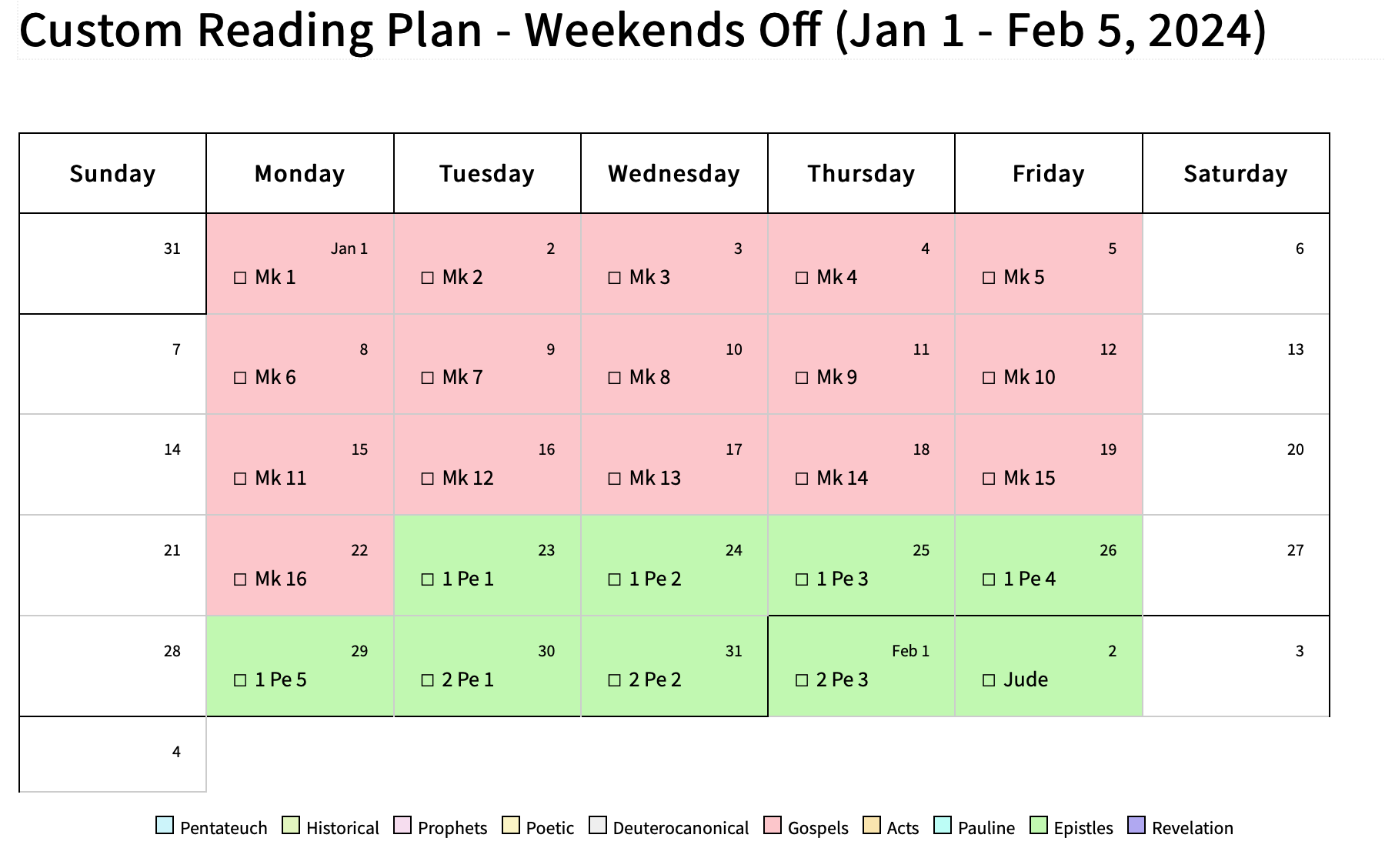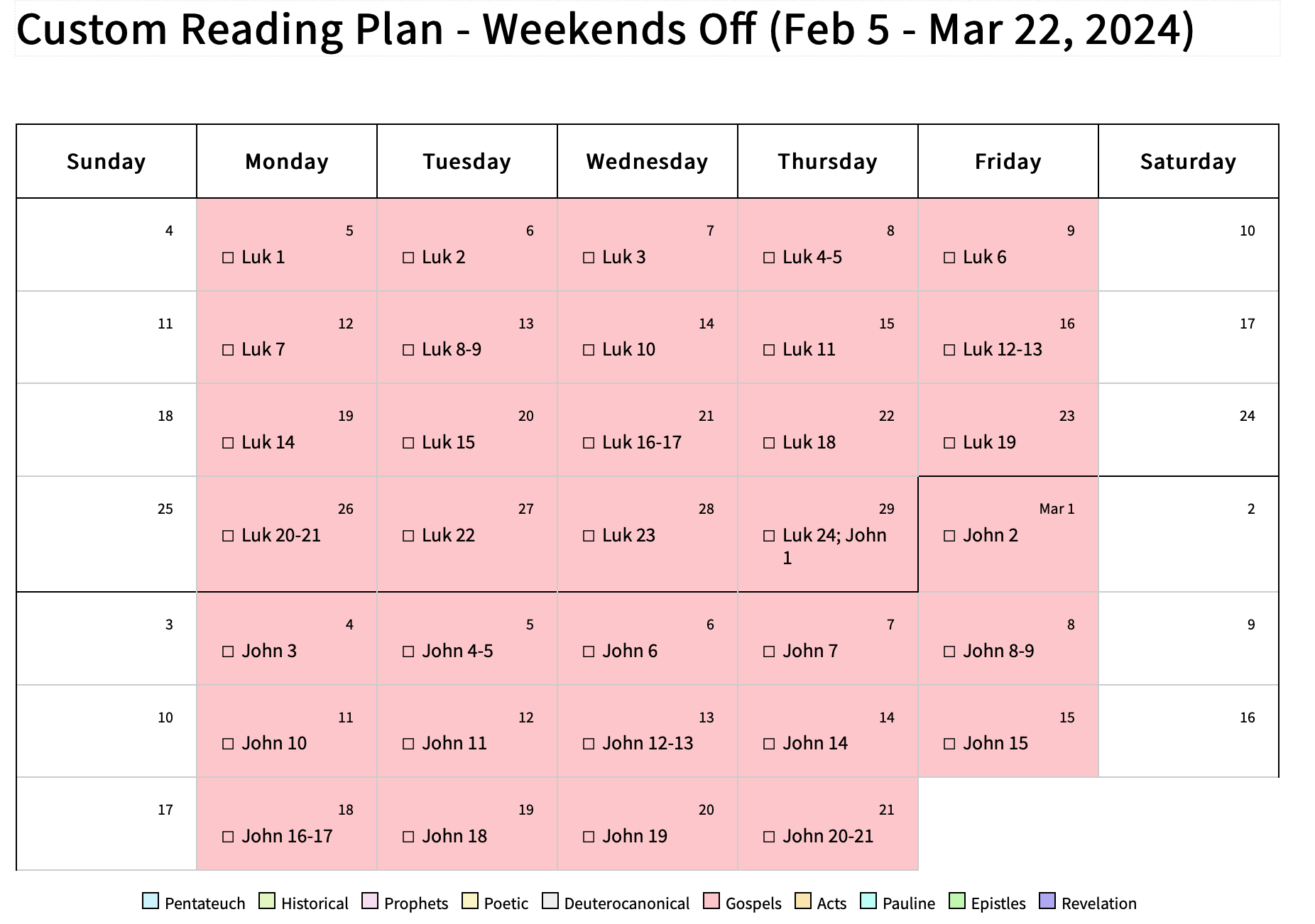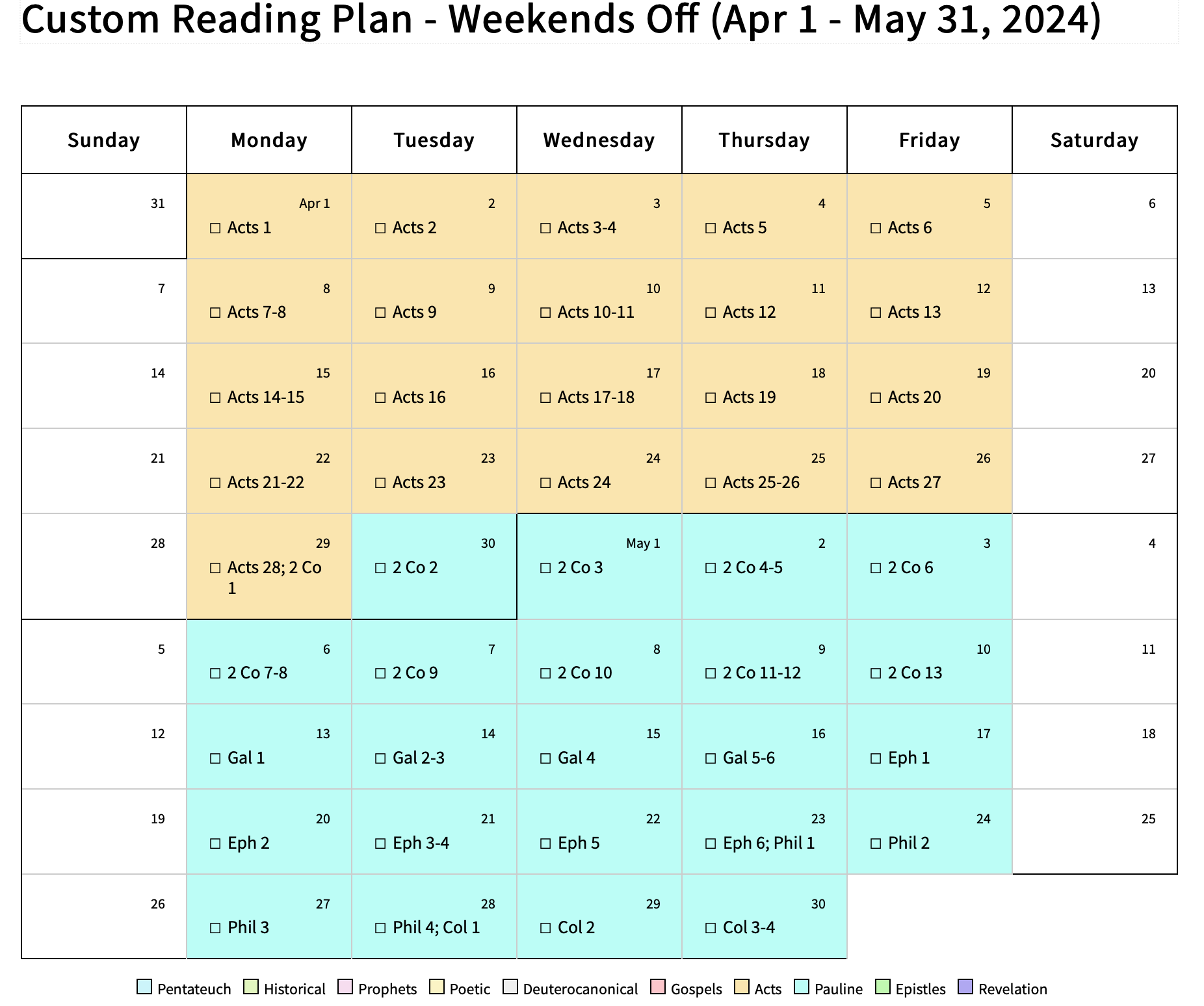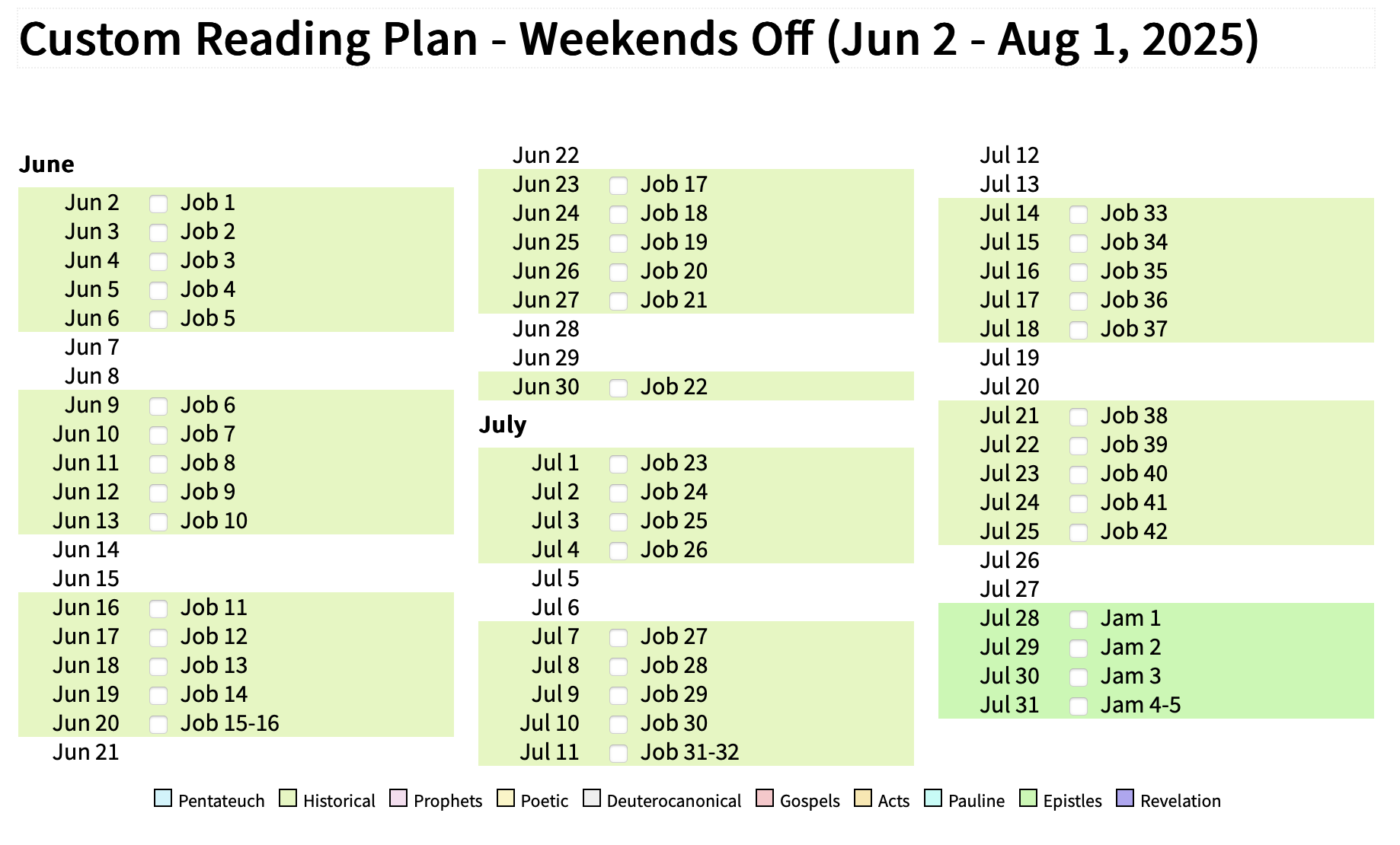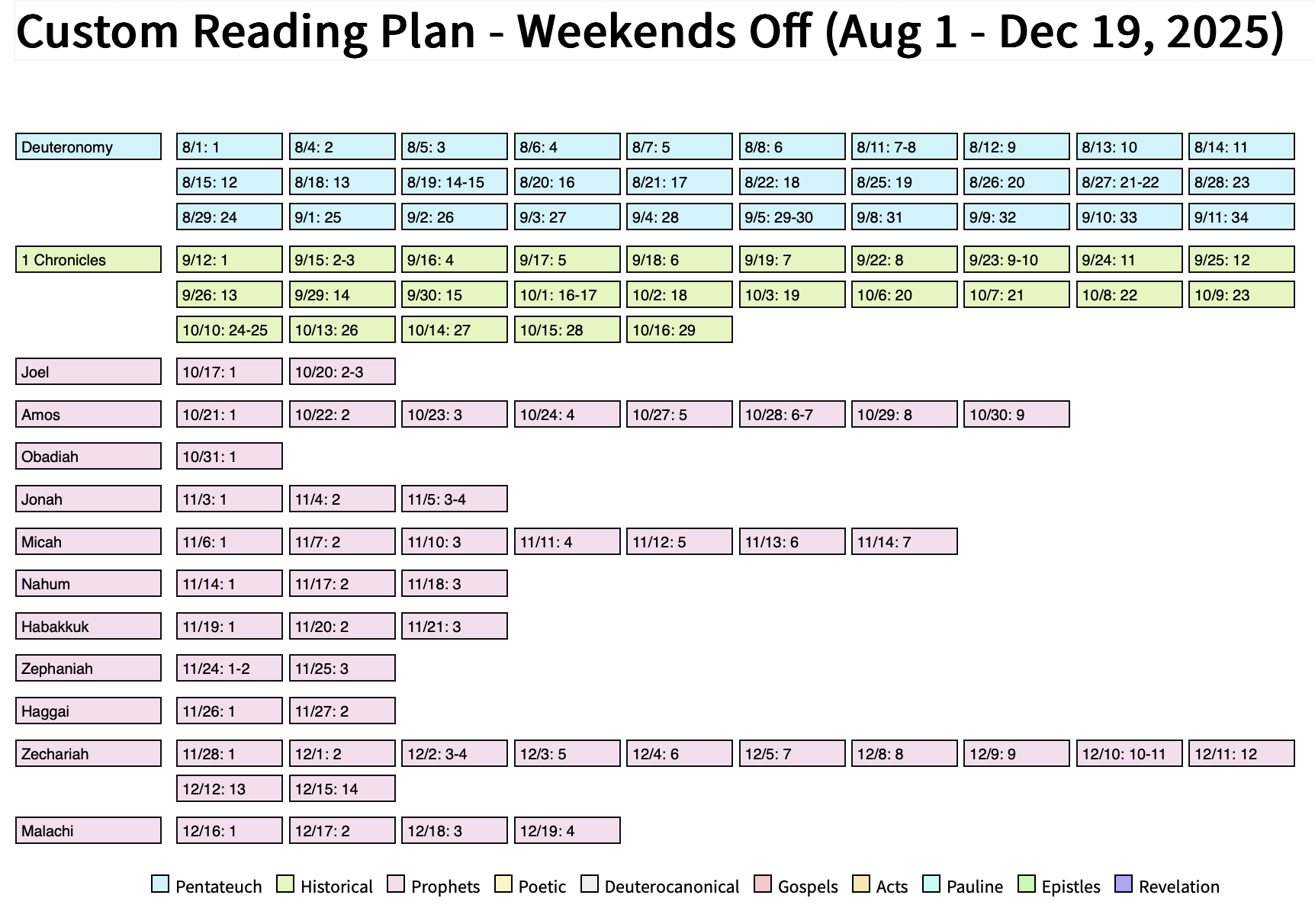Goals
When I was developing our church’s Bible reading plan, I had the following goals:
-
Provide a manageable (two readings each weekday; one of those readings being a Psalm or Proverb) diet of Scripture which (a) reads through books (or large portions of books) and (b) substantially reads the entire Bible over ~5 years.
-
Thoughtfully group books together by audience, author, timeline, etc.1
-
Satisfy three natural calendars (school, church, and solar) by starting in the Old Testament in late-summer (school) in order to lead up to messianic prophecies in Advent (church) which in turn naturally flows into the Gospels, Acts, and the epistles starting in January (solar). (In terms of preaching, I will generally focus on one Gospel at the beginning of each year based on a four-year cycle (Years A, B, C, D).2)
Basic Structure
Supporting these goals, I use the following structures to aid in creation of the plan:
- January until Holy Week: Gospels (and related New Testament books3) and other Gospels.
- Year A: Matthew, Hebrews, and James
- Year B: Mark, 1 & 2 Peter, Jude
- Year C: Luke and other Pauline Epistles not being read that year
- Year D: John, 1, 2, 3 John, Revelation
- Holy Week - Use plans from Bible.com (including this plan) or from the American Bible Society. Or, one may simply follow the Holy Week narrative through that year’s Gospel.
- After Holy Week through May: Acts and Epistles with the following four-year cycle (which follows the Gospel four-year cycle):
- Acts
- Year A: Acts 1:1-5:42
- Year B: Acts 6:1-12:25
- Year C: Acts 13:1-21:16 (Paul’s Missionary Journeys)
- Year D: Acts 21:17-28:31 (Paul’s Imprisonment)
- Epistles
- Year A: Romans and 1 Corinthians
- Year B: 2 Corinthians to Colossians
- Year C: 1 Thessalonians to Philemon
- Year D: Hebrews to 2 Peter and Jude (Johannine writings of 1-3 John and Revelation are read with Gospel of John earlier in the year.)
- Acts
- June: Wisdom
- Year A: Job 1-25
- Year B: Job 26-42
- Year C: Ecclesiastes and Song of Songs
- July through Christmas week: Pentateuch, History, and Prophets grouped on five-year rotation:4
- Year A: Genesis, Joshua, Judges, Ruth, and Isaiah 1-39 (138 chapters)
- Year B: Exodus, 1 & 2 Samuel, and Isaiah 40-66 (138 chapters)
- Year C: Leviticus, 1 & 2 Kings, Jeremiah, and Lamentations (141 chapters)
- Year D: Numbers, Ezra, Nehemiah, Esther, Ezekiel, Jonah, Micah, Nahum, Habakkuk, and Zephaniah (137 chapters)
- Year E: Deuteronomy, 1 & 2 Chronicles, Daniel, Haggai, Zechariah, and Malachi (131 chapters)
- Christmas Week - Similar to Holy Week, use plans from Bible.com or from the American Bible Society.
2024 Example
Note: The final version would include a daily psalm.
January 1 through March 22
2024 will be Year B for the Gospels and thus begin with the Gospel of Mark:
The plan continues with two other Gospels:
Holy Week
Choose a series of Scriptures from a Lent Bible reading plan such as this one or this one.
April 1 through May 31
Acts and then 2 Corinthians through Colossians:
June 1 through July 31
Freestyle: Scriptures TBD
August 1 through December 20
2024 will be Year D for the Old Testament and thus begin with Numbers:
Christmas Week
Chose a series of Scriptures from an Advent Bible reading plan such as this.
2025 Example
January 1 through May 30
Following the guidance above, 2025 will be Year C for the Gospels and thus begin with the Gospel of Luke. The related New Testament books (following the the Ten Minute Bible Talks Reading Plan 2023) include Acts 1-14, Galatians, Acts 15-18, 1 & 2 Thessalonians, Acts 19, 1 & 2 Corinthians, Acts 20, Romans, Acts 21-24, Colossians, Philemon, Ephesians, Philippians, Acts 25-28, Titus, 1 & 2 Timothy.
Two notes:
- Although we would typically read Acts and various epistles following Easter, reading Luke and his related book (Acts) with the Pauline epistles inserted at the appropriate places will make for a more cohesive experience.)
- Because we’re interspersing Acts, there are no graphics (as with 2024) from BibleReadingPlanGenerator.com.
June 1 through July 31
During summer, we’ll read Job and James as we haven’t read them recently. In addition, the 47 total chapters in Job and James fit well within the 44 weekdays.
August 1 through December 19
2025 will be Year E for the Old Testament and thus include with Deuteronomy, 1 Chronicles, and Joel through Malachi.
2026 Example
January 1 through March 27
2026 will be Year C for the Gospels and thus begin with the Gospel of John and be followed by other Johannine writings including 1-3 John and Revelation. We’ll read the Gospel of Mark before entering Holy Week.
Holy Week
Rather than read various Gospels during Holy Week, I’ve opted to stay in our Gospel and read John 12-20.
April 6 through May 29
Mostly following the plan (above), we are reading Acts – but starting with Paul’s third missionary journey and then continuing to Hebrews through 2 Peter and Jude.
June
In a departure from the past, we are reading the remaining wisdom books (over a three-year cycle) that are not read during the year: Job, Ecclesiastes, and Song of Songs. In 2026, we’ll focus on Ecclesiastes and Song of Songs.
July 1 through December 17
In order to get through more of the Old Testament, I moved the start date up from August 1 to July 1. I also simplified the readings such that they continue year-after-year. For example, 1 & 2 Samuel are read in Year B, and then 1 & 2 Kings are read in Year C.
As a result, we’ll read Year A: Genesis, Ezra, Nehemiah, Esther, and Isaiah 1-39.
Note: The plan (above) has us reading Joshua, Judges, Ruth. Because we just read that in 2024, I substituted Ezra, Nehemiah, and Esther.
Christmas Week
Similar to Holy Week, I chose excerpts from the Gospel – specifically, Matthew, the Gospel we’ll read in 2027.
The Secondary Readings
We continue to read the Psalms and Proverbs as the secondary reading. However, I’ve interspersed them as follows:
- Psalms: Book 1: Psalms 1-41
- Proverbs 1-9
- Psalms: Book 2: Psalms 42-72
- Proverbs 10-22
- Psalms: Book 3: Psalm 73-89
- Proverbs 22-24
- Psalms: Book 4: Psalms 90-106
- Proverbs 25-29
- Psalms: Book 5: Psalms 107-150
- Proverbs 30-31
After we read through this, we re-read the Proverbs in October and November.
We conclude the calendar year, but utilizing readings from the ACNA Sunday lectionary.
In the future, I plan to continue to use this paradigm for the secondary readings.
-
I got this idea from Westminster Presbyterian Church’s’s 4-year Bible reading plan from 2019 to 2022: “The New Testament features a Gospel, followed by the books most associated with that Gospel. So Matthew’s Gospel, written with a Jewish audience in mind, is followed by the most Hebraic books of the NT, Hebrews and James. Mark’s Gospel, written under Peter’s authority, is followed by Peter’s two letters and Jude. Luke travelled with Paul, so his Gospel precedes Paul’s letters, and finally, John’s writings are grouped together.” A similar approach is taken by the Ten Minute Bible Talks Reading Plan 2023. ↩︎
-
This idea was adopted from the Narrative Lectionary. ↩︎
-
See the second goal and related footnote. ↩︎
-
Not to be confused with the four-year Gospel preaching cycle. ↩︎
